Related Research Articles

Operation Cycle is the name of the evacuation of Allied troops from Le Havre, in the Pays de Caux of Upper Normandy from 10–13 June 1940, towards the end of the Battle of France, during the Second World War. The operation was preceded by the better known rescue of 338,226 British and French soldiers from Dunkirk in Operation Dynamo (26 May – 4 June). On 20 May, the Germans had captured Abbeville at the mouth of the Somme and cut off the main Allied armies in the north. South of the river, the Allies improvised defences and made local counter-attacks, to dislodge the Germans from bridgeheads on the south bank and re-capture river crossings for an advance northwards to regain contact with the armies in northern France and Flanders.
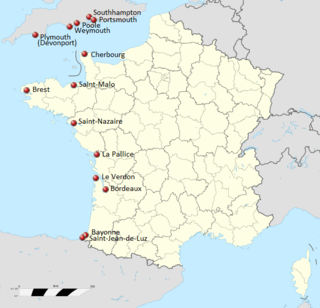
Operation Aerial was the evacuation of Allied military forces and civilians from ports in western France. The operation took place from 15 to 25 June 1940 during the Second World War. The embarkation followed the Allied military collapse in the Battle of France against Nazi Germany. Operation Dynamo, the evacuation from Dunkirk and Operation Cycle from Le Havre, had finished on 13 June. British and Allied ships were covered from French bases by five Royal Air Force (RAF) fighter squadrons and assisted by aircraft based in England to lift British, Polish and Czech troops, civilians and equipment from Atlantic ports, particularly from St Nazaire and Nantes.

I Corps was an army corps in existence as an active formation in the British Army for most of the 80 years from its creation in the First World War until the end of the Cold War, longer than any other corps. It had a short-lived precursor during the Waterloo Campaign. It served as the operational component of the British Army of the Rhine during the Cold War, and was tasked with defending West Germany.

The 52nd (Lowland) Infantry Division was an infantry division of the British Army that was originally formed as the Lowland Division, in 1908 as part of the Territorial Force. It later became the 52nd (Lowland) Division in 1915. The 52nd (Lowland) Division fought in the First World War before being disbanded, with the rest of the Territorial Force, in 1920.
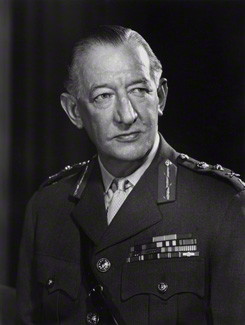
Field Marshal Sir Archibald James Halkett Cassels, was a senior British Army officer who served as Chief of the General Staff (CGS), the professional head of the British Army, from 1965 to 1968. As a young man he was a first-class cricket player, initially playing in India for the Europeans against the Hindus in the Lahore Tournament and going on to play for a Punjab Governor's XI against Northern India team and for a Viceroy's XI against the Roshanara Club. He later played for the British Army cricket team against the RAF at The Oval and then played for the Egyptian national side against HM Martineau's XI in Alexandria.

The II Corps was an army corps of the British Army formed in both the First World War and the Second World War. There had also been a short-lived II Corps during the Waterloo Campaign.
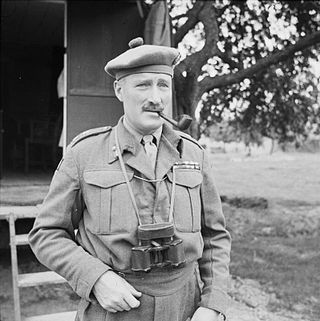
General Sir Neil Methuen Ritchie, was a British Army officer who saw service during the world wars. He is most notable during the Second World War for commanding the British Eighth Army in the North African campaign from November 1941 until being dismissed in June 1942. He later commanded XII Corps throughout the campaign in North West Europe, from June 1944 until Victory in Europe Day in May 1945.

General Sir John Tredinnick Crocker, was a senior British Army officer who fought in both world wars. He served as both a private soldier and a junior officer in the First World War. During the Second World War he served as a distinguished brigade, division and corps commander, where his most notable role was as General Officer Commanding (GOC) of I Corps during the D-Day landings on 6 June 1944, leading the corps throughout the subsequent campaign in Western Europe until Victory in Europe Day (VE-Day) just over eleven months later.

The Glasgow Highlanders was a former infantry regiment of the British Army, part of the Territorial Force, later renamed the Territorial Army. The regiment eventually became a Volunteer Battalion of the Highland Light Infantry in 1881. The regiment saw active service in both World War I and World War II. In 1959 the Highland Light Infantry was amalgamated with the Royal Scots Fusiliers to form the Royal Highland Fusiliers. The Glasgow Highlanders was later amalgamated into the 52nd Lowland Volunteers in 1967.

The 59th (Staffordshire) Infantry Division was an infantry division of the British Army that was formed during the Second World War and fought in the Battle of Normandy. In March 1939, after Germany re-emerged as a significant military power and invaded Czechoslovakia, the British Army increased the number of divisions in the Territorial Army (TA) by duplicating existing units. The 59th (Staffordshire) Motor Division was formed in September 1939, as a second-line duplicate of the 55th Motor Division. The division's battalions were all, initially, raised in Staffordshire.
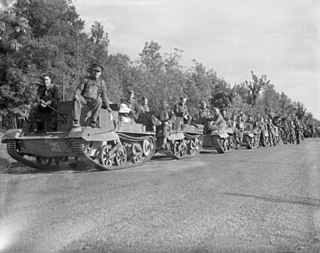
The British Expeditionary Force (BEF) was the contingent of the British Army sent to France in 1939 after Britain and France declared war on Nazi Germany on 3 September, beginning the Second World War. The BEF existed from 2 September 1939 when the BEF GHQ was formed until 31 May 1940, when GHQ closed down and its troops reverted to the command of Home Forces. During the 1930s, the British government had planned to deter war by abolishing the Ten Year Rule and rearming from the very low level of readiness of the early 1930s. The bulk of the extra money went to the Royal Navy and the Royal Air Force but plans were made to re-equip a small number of Army and Territorial Army divisions for service overseas.

The Beauman Division was an improvised formation of the British Expeditionary Force (BEF) during the Second World War, which fought in France against the German 4th Army in June 1940, during Fall Rot, the final German offensive of the Battle of France.
The 156th Brigade was an infantry brigade formation of the British Army. The brigade saw active service in both the First and the Second World Wars with the 52nd (Lowland) Infantry Division.
The 155th Brigade was an infantry brigade of the British Army that saw active service in both the First and the Second World Wars. Assigned to the 52nd (Lowland) Division, the brigade saw active service in the Middle East and on the Western Front during the First World War. During the Second World War, now the 155th Infantry Brigade, it continued to serve with the 52nd Division in Operation Dynamo, and later in North-western Europe from late 1944 until May 1945.
The 157th Brigade was an infantry brigade of the British Army. The brigade fought in both the First and the Second World Wars, assigned to 52nd (Lowland) Infantry Division.
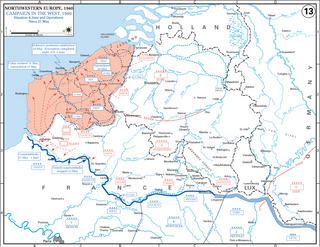
The Battle of Abbeville took place from 27 May to 4 June 1940, near Abbeville during the Battle of France in the Second World War. On 20 May, the 2nd Panzer Division advanced 56 mi (90 km) to Abbeville on the English Channel, overran the 25th Infantry Brigade of the 50th (Northumbrian) Infantry Division and captured the town at 8:30 p.m. Only a few British survivors managed to retreat to the south bank of the Somme and at 2:00 a.m. on 21 May, the III Battalion, Rifle Regiment 2 reached the coast, west of Noyelles-sur-Mer.
The Battle of the Ypres–Comines Canal was a battle of the Second World War fought between the British Expeditionary Force (BEF) and German Army Group B during the BEF's retreat to Dunkirk in 1940. Part of the Battle of Belgium and the much larger Battle of France, it started in the afternoon of 26 May and reached its maximum intensity on 27 and 28 May. Locally it is referred to as the Battle of the Canal and it is sometimes incorrectly referred to as the Battle of Wytschaete. Its official British Army name, which is borne on the battle honours of a number of regiments, is that given here.
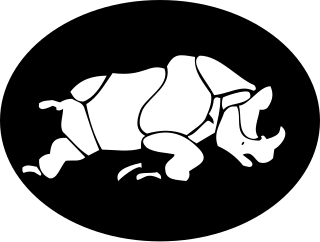
The 1st Armoured Division was an armoured division of the British Army. It was formed as the Mobile Division on 24 November 1937, after several years of debate on the creation of such a formation. It was then renamed, in April 1939, the 1st Armoured Division. Following the start of the Second World War, in September 1939, subordinate units and formations were withdrawn from the division to reinforce others. Then, in May 1940, the division was deployed to France and then fought in the Battle of France. After several engagements and heavy tank losses, it was forced to withdraw to the UK, in June, during Operation Aerial. In late 1941, the division was sent to North Africa where it took part in the Western Desert campaign, notably fighting at the Battle of Gazala, and the First and the Second Battles of El Alamein.

79th (Lowland) Field Regiment was a Royal Artillery (RA) unit of Britain's part-time Territorial Army (TA) during World War II. It was descended from the 1st Ayrshire and Galloway Artillery Volunteers, first raised in Scotland in 1859. It served in Home Forces for most of the war, undergoing training in mountain warfare and air-portable operations before eventually going into action at sea level in the Battle of the Scheldt. It then took part in the fighting in the Rhineland, and then the drive to Bremen. It was reformed in the postwar TA, and continued until 1967.

80th Field Regiment was a Royal Artillery (RA) unit of Britain's part-time Territorial Army (TA) during World War II. It was descended from the 1st Lanarkshire Artillery Volunteers, first raised in Scotland in 1859. It served in Home Forces for most of the war, undergoing training in mountain warfare and air-portable operations before eventually going into action at sea level in the Battle of the Scheldt. It then took part in the fighting in the Rhineland, and then the drive to Bremen. It was reformed in the postwar TA, and continued until 1961.
References
- Alanbrooke, Field Marshal Lord (2002) [2001]. Danchev, Alex; Todman, Daniel (eds.). War Diaries (Phoenix Press, London ed.). London: Weidenfeld & Nicolson. ISBN 978-1-84212-526-7.
- Ellis, L. F. (2004) [1953]. Butler, J. R. M. (ed.). The War in France and Flanders 1939–1940. History of the Second World War United Kingdom Military Series (facs. repr. Naval & Military Press ed.). HMSO. ISBN 978-1-84574-056-6 . Retrieved 1 September 2015.